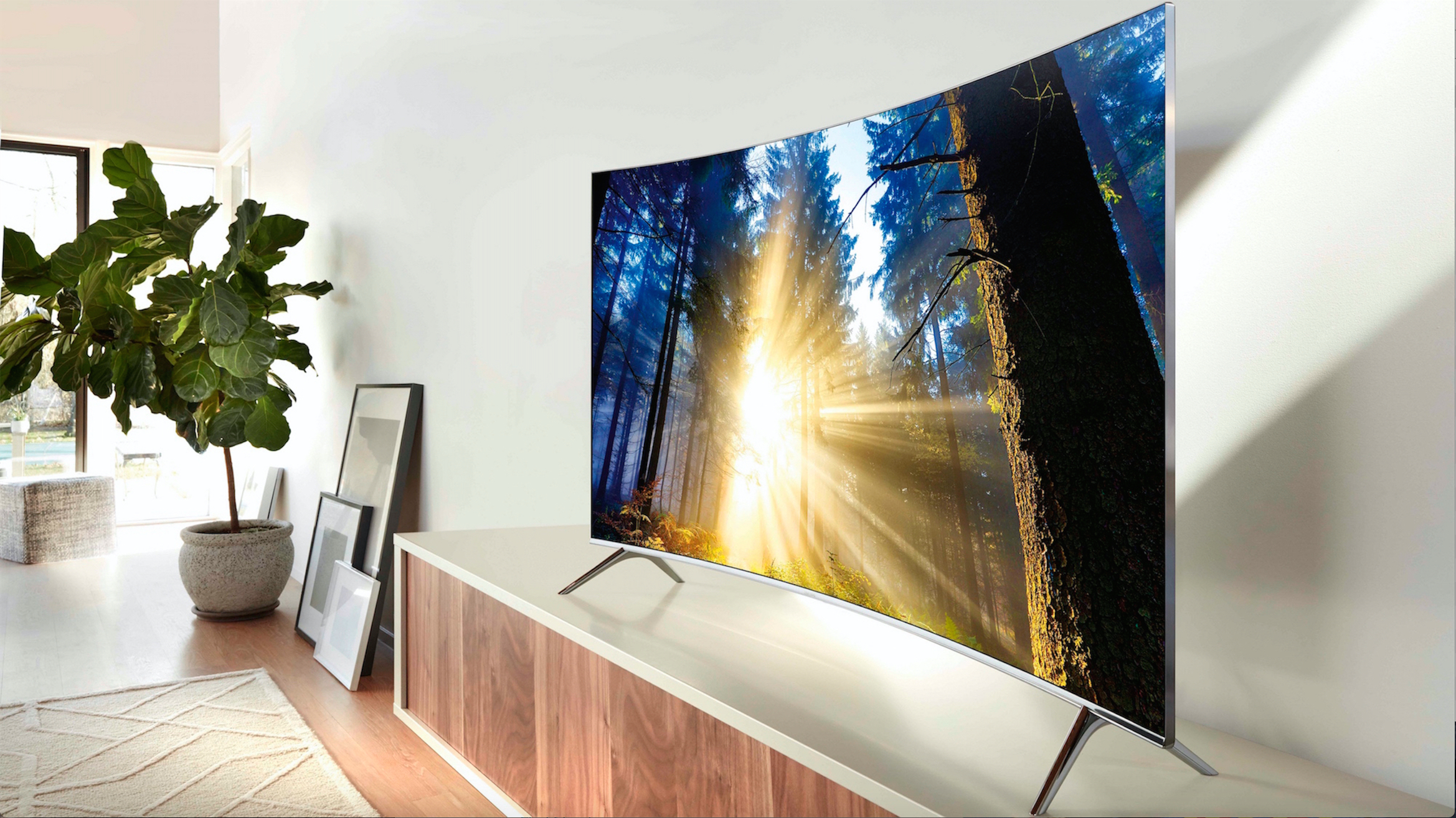TechRadar Verdict
It’s easy to imagine the UE43KS7500 flying off the shelves. After all, it looks achingly cute in its svelte curved bodywork, it ticks all the right up-to-the-minute 4K and HDR specification boxes, and it’s startlingly affordable for such a heavily featured TV. In the end, though, Samsung’s flat KS7000 series is the better bet.
Pros
- +
Strong HDR picture quality
- +
Attractive design
- +
Affordable for genuine HDR
- +
Low input lag
Cons
- -
Bit small for 4K
- -
Curved screen feels unnecessary
- -
Curved screen adds cost
- -
Some backlight flaws
Why you can trust TechRadar
Although the TV size trend continues to march inexorably upwards, there are still plenty of people who don’t want, can’t afford or can’t accommodate a really massive screen, but who would still like their new TV to carry the latest cutting-edge features and picture quality. If this sounds like you, then the Samsung UE43KS7500 could be the answer to your prayers.
It measures just 43 inches from corner to corner, making it the smallest 4K TV in Samsung’s 2016 range. Its screen is also curved, making it the smallest curved TV in Samsung’s 2016 range. Even more impressive, however, is its price tag: £799. On top of everything else it not only plays high dynamic range video, but does so to the standards laid out by the AV industry’s Ultra HD Premium set of recommended specifications.
At first look, the UE43KS7500 appears to be one of the top televisions of the year. But, as they always say, some things aren’t as they appear to be.
Design
While the pros and cons of curved TVs are always up for debate, there’s no doubt that the UE43KS7500’s curve helps it bag some extra style points. Especially as the curve is backed up by an exceptionally narrow bezel and a trim, smoothly finished rear.
The curve becomes less cute, however, if you want to wall mount the UE43KS7500, as it makes the edges of the screen bend away from the wall. Also, the way the UE43KS7500’s legs fasten to the extremities of the screen’s bottom edge means you’ll need a piece of furniture to stand the TV on that’s at least as wide as the TV. (Tip: Check out the dimensions in the specifications below this section if you’re concerned about this.)
As with all of Samsung’s so-called SUHD TVs, most of the UE43KS7500’s connections are found on an external ‘One Connect’ box. They include four HDMIs, a trio of USBs, and the now inevitable Ethernet network port. Wi-Fi networking is also supported of course, and all the HDMIs are built to the latest 2.0a, HDCP 2.2 specification, for playback of 4K and HDR signals.
Screen sizes available: 43-inch, 49-inch, 55-inch, 65-inch | Tuner: Freeview HD | 4K: Yes | HDR: Yes | Panel technology: Edge LED with local dimming | Smart TV: Yes, 2nd-Gen Tizen OS | Curved: Yes | Dimensions: 956.5 x 554.5 x 83.1mm (W x H x D) | 3D: No | Inputs: Four HDMIs, Three USBs, RF digital tuner port, optical digital audio output, RS-232C, Ethernet port, CI Slot
Design TL;DR: You’ll struggle to find a cuter-looking or better connected small-screen TV this year. That said the curved screen doesn’t lend itself to wall mounting, and its edge-mounted feet could present you with a problem if your TV stand isn’t at least as wide as the TV.
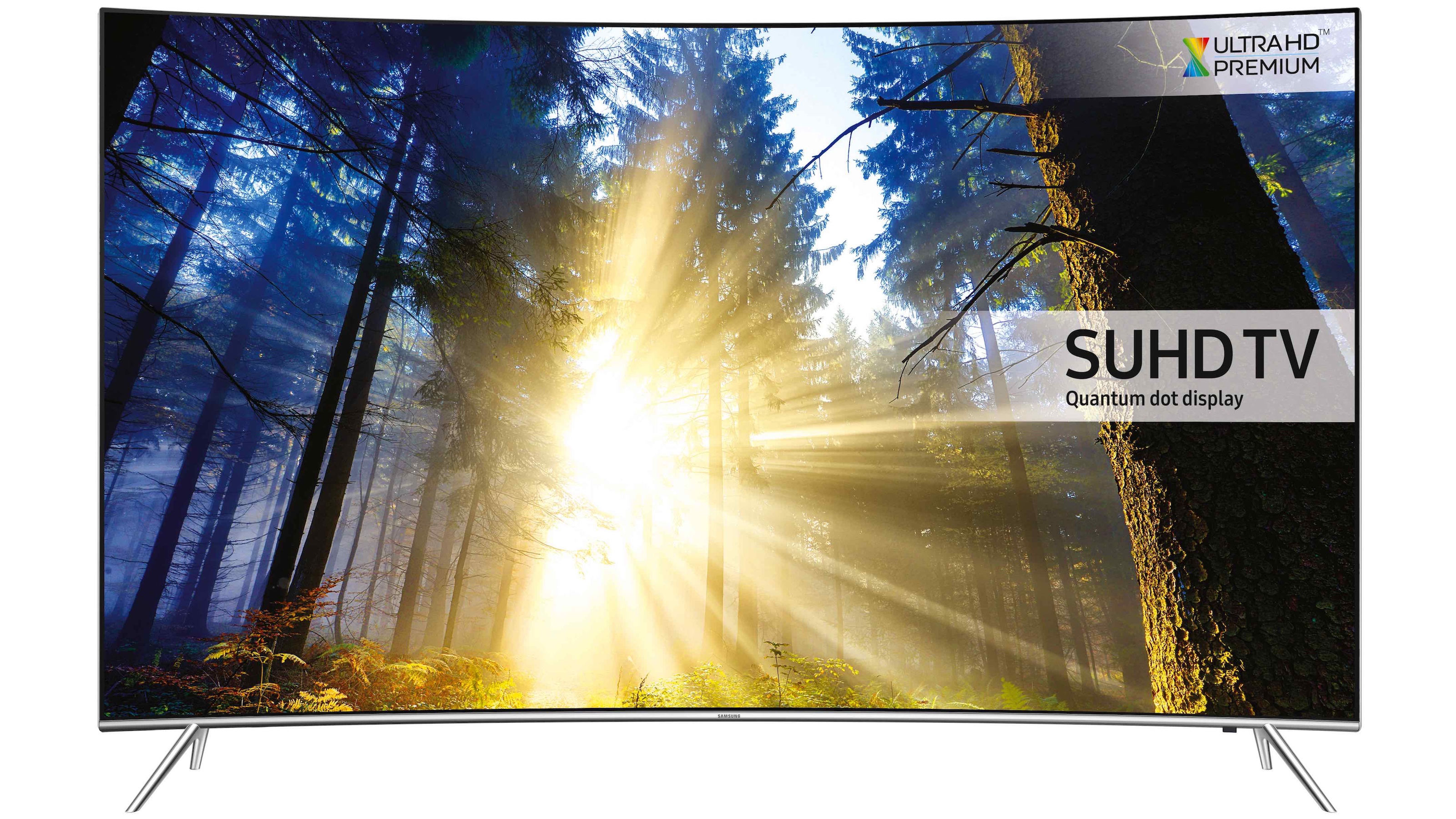
Smart TV (Tizen)
Let’s get the bad news about the UE43KS7500’s smart TV system out of the way first: Namely, at the time of writing, there’s no support for the All4 or My5 UK terrestrial broadcaster catch up apps. All you'll find here are the BBC iPlayer and the ITVHub. This is strange given that both these now-missing services have appeared on Samsung Smart TVs in previous years.
What you do get here are 4K and HDR-compatible versions of both Netflix and Amazon Prime, though, along with a decently expansive - though not unmanageably so - selection of utility and gaming apps.
The Tizen-based smart TV platform Samsung introduced in 2015 introduced a much slicker, less intrusive interface than anything Samsung had managed before. And while the 2016 iteration isn’t a radical departure from Tizen’s debut last year, the addition of a second deck of icons on the main screen that provides pop-out options based on the selection you’ve made on the bottom deck is a welcome one.
Smart TV TL;DR: While it would be nice to see Samsung get back to offering support for all the UK’s ‘big four’ terrestrial catch-up TV platforms, the latest Tizen interface is clean, slick and does a good job of helping you quickly find the content you want.
HD/SDR performance
The relatively extreme demands of HDR content mean that good HDR-capable TVs tend to excel with standard dynamic range content, too. The UE43KS7500 continues this trend.
Its contrast performance, in particular, is exceptional with SDR for a TV that’s illuminated by edge LED lighting. Dark scenes benefit from black level depths rivalled at the same price level only by Samsung’s own KS7000 models (which are essentially flat screen equivalents to the KS7500s).
What’s more, the UE43KS7500 presents contrast-rich dark SDR scenes with only relatively minor signs of the vertical light banding often seen with edge LED TVs that use local dimming to output different amounts of light from different clusters of their LEDs.
Colours are expertly handled in SDR, too. The HDR-friendly Quantum Dot colour system adapts beautifully to SDR’s narrower requirements, ensuring that while the colour palette looks slightly punchier than usual for a mid-range TV, this punch doesn’t look unnatural and doesn’t come at the expense of subtlety.
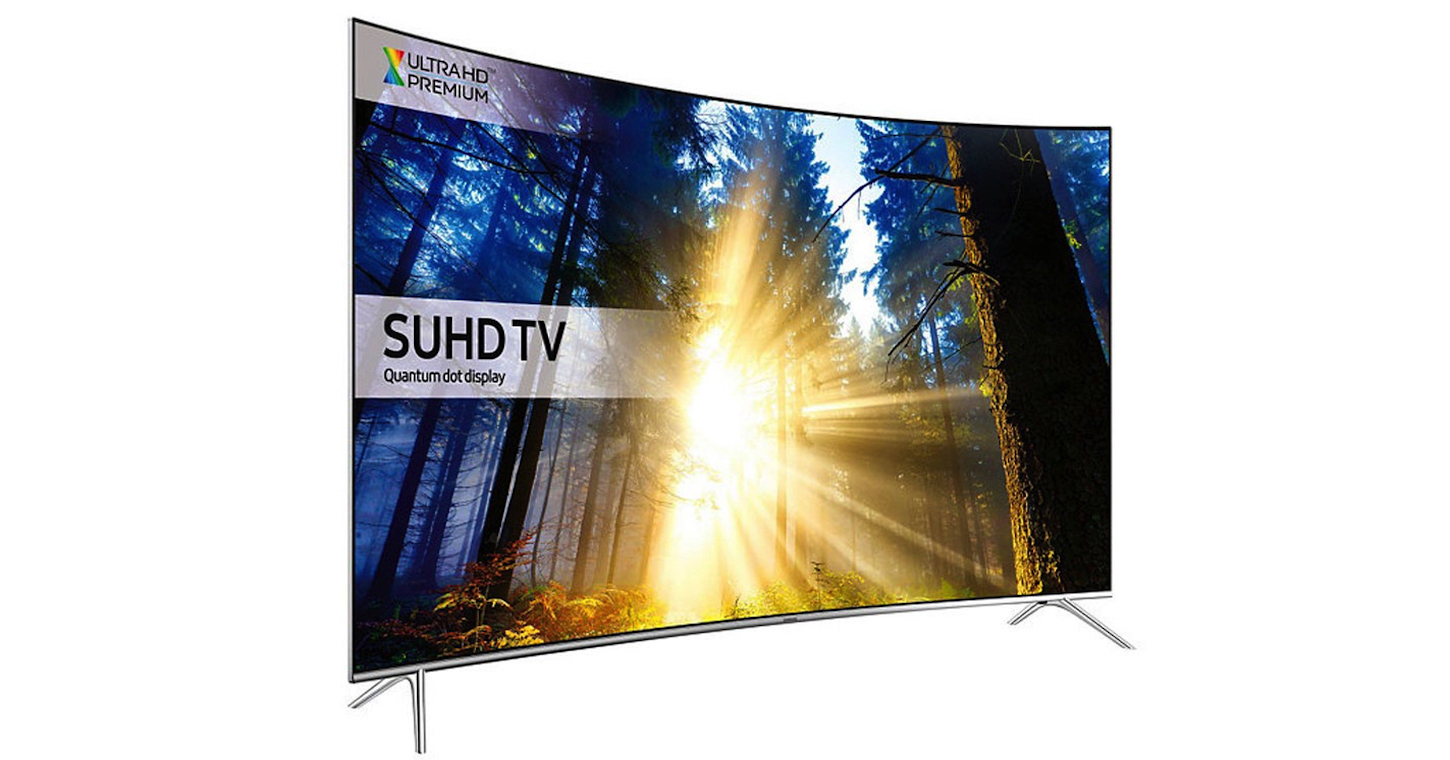
On the contrary, colour blends and slight tonal shifts are handled with impressive delicacy, helping the picture look more detailed, expressive and immersive.
HD sources such as Blu-rays or HD broadcasts also excel on the UE43KS7500 thanks to Samsung’s superb Ultra HD upscaling. The process does a great job of separating out noise from actual picture information during the upscaling process, while tricky areas such as thin white lines and bright curved edges are upscaled without over-emphasis, jaggedness or ‘haloing’.
The UE43KS7500 is a good handler of motion in SDR/HD mode. There’s hardly any motion blur to reduce the sharpness of action scenes even if you leave the set’s motion processing system turned off. There can be a little judder with 24fps movies, but Samsung’s motion processing can deal with this fairly astutely - especially if you choose the Custom motion setting and set judder to around its four level.
The only significant issue with the UE43KS7500’s standard dynamic range/HD performance is a general one that actually affects all source types: a limited viewing angle. The curvature of the screen essentially means that anyone watching from an angle of more than, say, 30 degrees will start to experience a foreshortening effect. Add in how relatively small the UE43KS7500’s screen is and you’re talking about a really quite limited viewing ‘sweet spot’.
HD/SDR Performance TL;DR: The UE43KS7500 is pretty much only having to run in second gear with SDR/HD content, so it’s no great surprise to find it handling the ‘old’ formats with real panache and precision.
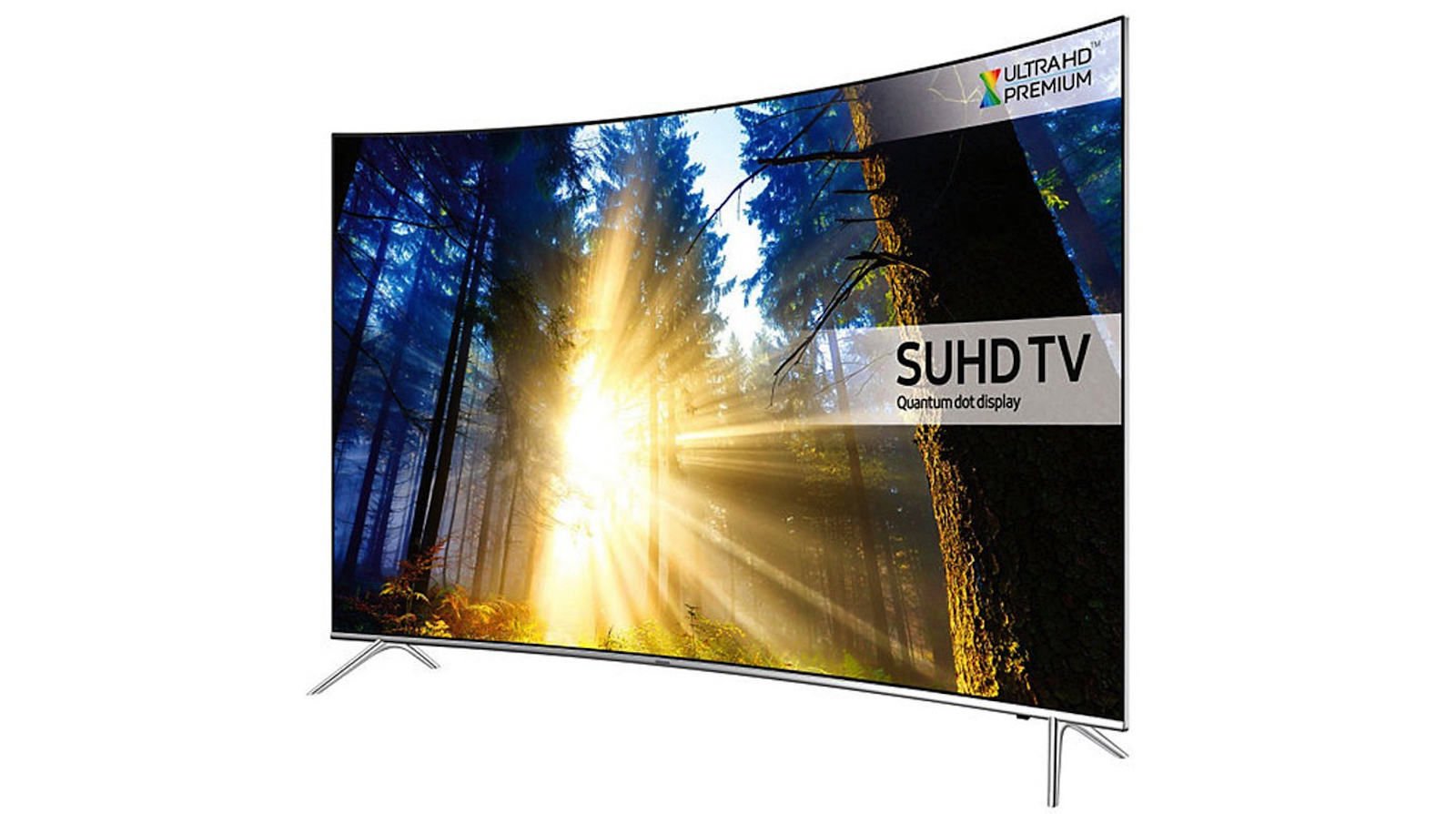
4K/HDR Performance
As noted earlier, the UE43KS7500 is built to the specifications laid out by the AV industry’s Ultra HD Premium certification scheme. This means it can hit brightness peaks beyond 1000 nits, black level depths of at least 0.05 nits, and a colour range that covers more than 90% of the so-called DCI-P3 colour spectrum used in digital cinemas. No other TV brand can match this level of specification at the UE43KS7500’s price point, which means almost by default that no other similarly priced non-Samsung TV can match its HDR performance.
The star of the show is the UE43KS7500’s brightness. Being able to hit 1000 nits proves invaluable in enabling the TV to reach the brightness peaks and, just as importantly, colour volumes that it’s becoming increasingly apparent are critical to a convincing HDR picture.It’s great to see, too, that there’s barely any clipping of detail in the brightest and/or most intensely coloured image areas. This is an extremely common problem with other mid-range and budget HDR TVs.
Another welcome surprise about the UE43KS7500’s HDR pictures, though, is their contrast. Edge-lit LED TVs understandably struggle to deliver light with enough localisation to handle high dynamic range light levels. Yet the UE43KS7500’s combination of a high-contrast VA-type panel and a surprisingly effective local dimming system means that bright HDR picture elements can share screen space with very dark elements surprisingly naturally.
Inevitably, however, the backlight isn’t flawless. With really extreme contrast shots you can sometimes see subtle vertical bars running the full height of the picture around stand-out areas of HDR brightness. However, these bars are actually less overt and thus more distracting on the KS7500 than they are on Samsung’s step-up KS8000 models.
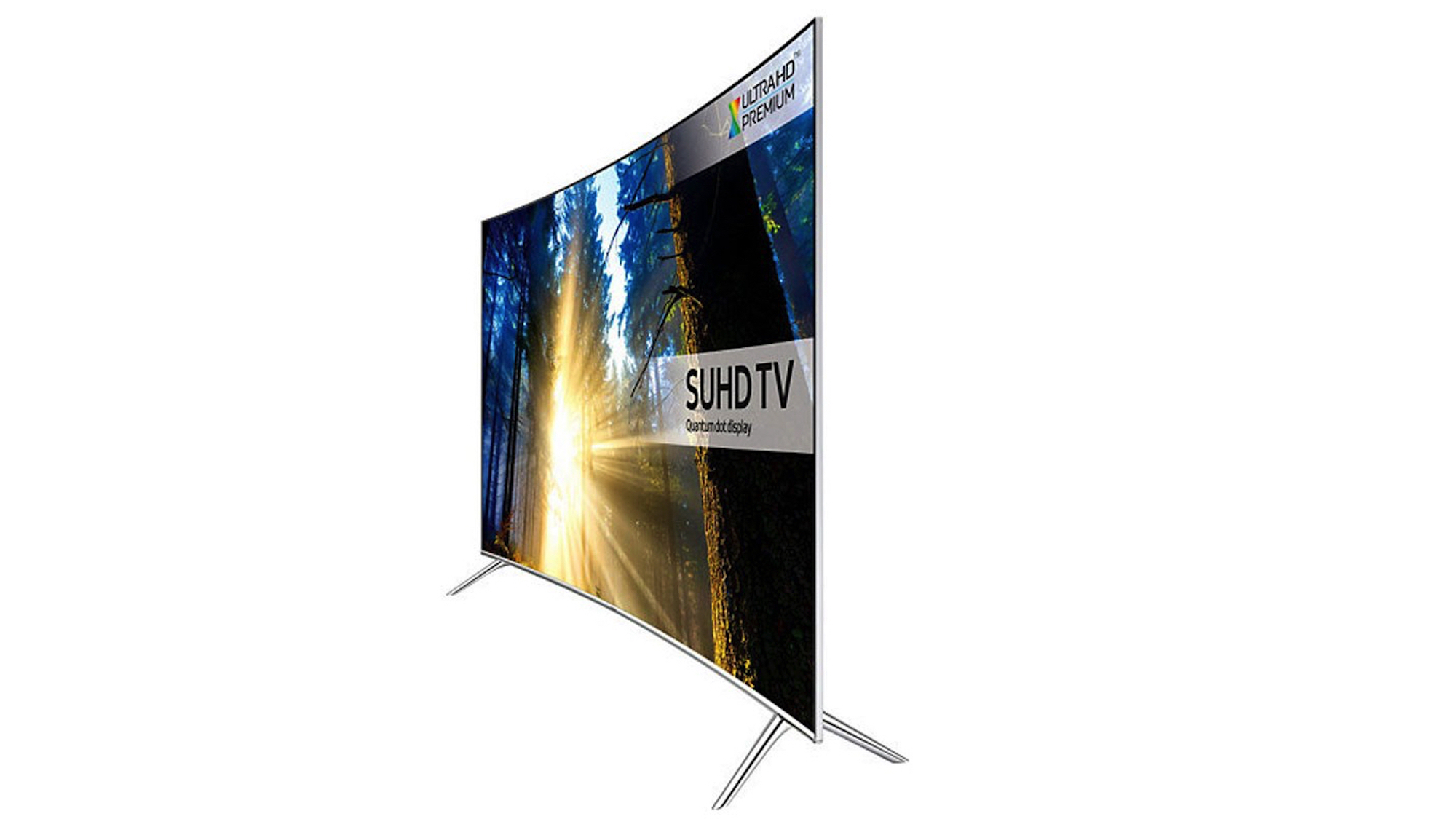
The UE43KS7500 does a remarkably good job for its money of delivering the expanded colour that’s so important to a really effective HDR image. It’s hard to fathom how Samsung has managed to get a Quantum Dot colour system into a TV as affordable as the UE43KS7500, but it’s there, and it performs brilliantly - especially with 1000 nits of brightness to give the rich colours more volume.
While the UE43KS7500 excels in many ways, though, there are a quartet of issues with its HDR/UHD playback - aside from the minor light banding - that ultimately mean it can only earn a qualified recommendation. Up first is colour banding when watching Ultra HD Blu-rays. Fortunately this issue only shows up over quite specific types of shot - usually those showing an expanse of sky. You can also reduce its impact by setting the Dynamic Contrast to its Medium level. But you can never remove the banding altogether.
There’s also more pronounced judder during camera pans when watching 24 frames a second Ultra HD content. You can tackle this with the set’s motion processing options, but only at the cost of a few unwanted processing side effects.
I’ve saved the two most telling flaws till last. Why telling? Because they’re don’t affect Samsung’s cheaper, flat-screen KS7000 models.

First, the UE43KS7500’s screen just doesn’t feel quite big enough to make the most of two of its key features: its curved screen, or its native Ultra HD Resolution. This wouldn’t necessarily be a big deal if the KS7500 series was equivalent in price to the KS7000 series, but it isn’t.
The other issue is that the UE43KS7500 suffers with some backlight clouding towards the middle of its bottom edge that the KS7000 model I tested does not. This clouding isn’t very intense, but it’s certainly a distraction you don’t get with its flat-screen 7000-series sibling.
In other words, while the UE43KS7500’s pictures perform extremely strongly versus those of any other brand of TV at a similar price, it ironically has some of the wind taken out of its sails by the efforts of one of its Samsung siblings.
4K/HDR Performance TL;DR: The UE43KS7500 is the best performing 40-43-inch HDR TV around. However, it performs slightly less well than Samsung’s cheaper, flat-screened KS7000 series, so if you can fit the smallest 49-inch UE49KS7000 into your home, I’d say go for that instead.
Sound
Despite its impressively trim lines, the UE43KS7500 is a perfectly respectable audio performer. It manages a reasonably open and clean mid-range, and it delivers solid treble detailing while seldom sounding harsh.
Voices are well rounded and natural, and while there’s not quite enough bass or treble extension to make the audio performance truly outstanding, there’s not really anything you can complain about on such a reasonably priced 4K HDR TV.
Sound quality TL;DR: Despite its slender design and lack of visible speakers, the UE43KS7500 sounds better than average.
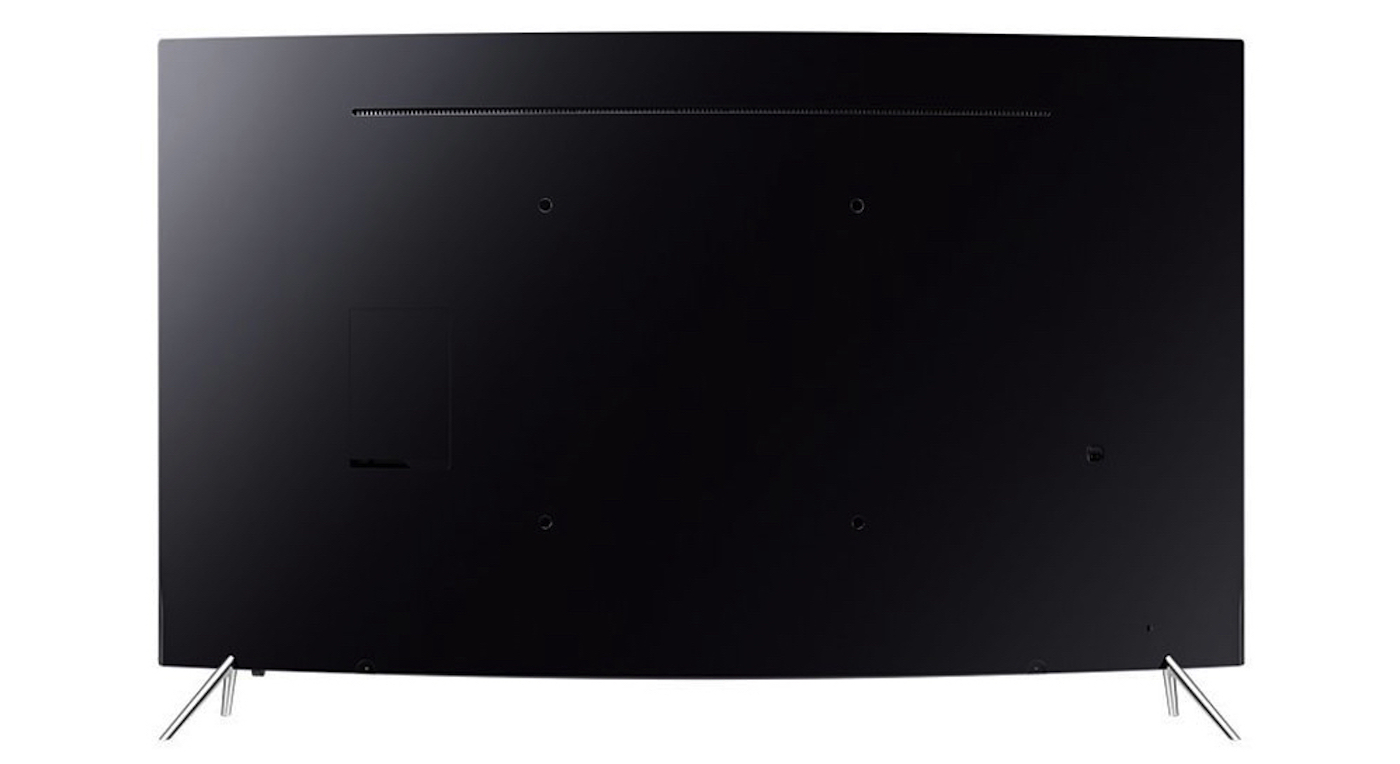
Other panels to ponder
Panasonic is the only brand aside from Samsung that’s consistently delivered real quality in the sub-£1,000 HDR market, and you can currently pick up its strong 50-inch 50DX750 for £850 and its more-than-respectable 50-inch 50DX700 for just £680.
While these screens excel with colour and balance and deliver Freeview Play, they don’t deliver the same colour or brightness range with HDR that Samsung’s SUHD models do. So if you want the most spectacular HDR experience for under £1,000 the only other option is another Samsung model like the KS7000 series.
Verdict
The UE43KS7500 has more going for it than most. It’s arguably the most attractive ‘small’ 4K TV I’ve seen this season, and it’s packed with cutting edge technology and features you wouldn’t normally find for so little money. These include genuinely high level high dynamic range playback, to the specifications defined by the Ultra HD Premium ‘standard’, and the presence of a UHD pixel count crammed into its 43-inch screen. The KS7500 is the only TV range aside from Samsung’s own KS7000 series which offers this level of HDR specification for so little money.
The UE43KS7500 also carries a fairly strong smart system aside from a couple of missing key UK catch-up TV apps, while it wraps its strong performance up with robust audio and outstanding playback of non-HDR content.
The only problem for the UE43KS7500 is that however much it outguns rival brands, it ultimately doesn’t look like quite such an attractive option in terms of price or performance as its own sibling KS7000 series.
John has been writing about home entertainment technology for more than two decades - an especially impressive feat considering he still claims to only be 35 years old (yeah, right). In that time he’s reviewed hundreds if not thousands of TVs, projectors and speakers, and spent frankly far too long sitting by himself in a dark room.
